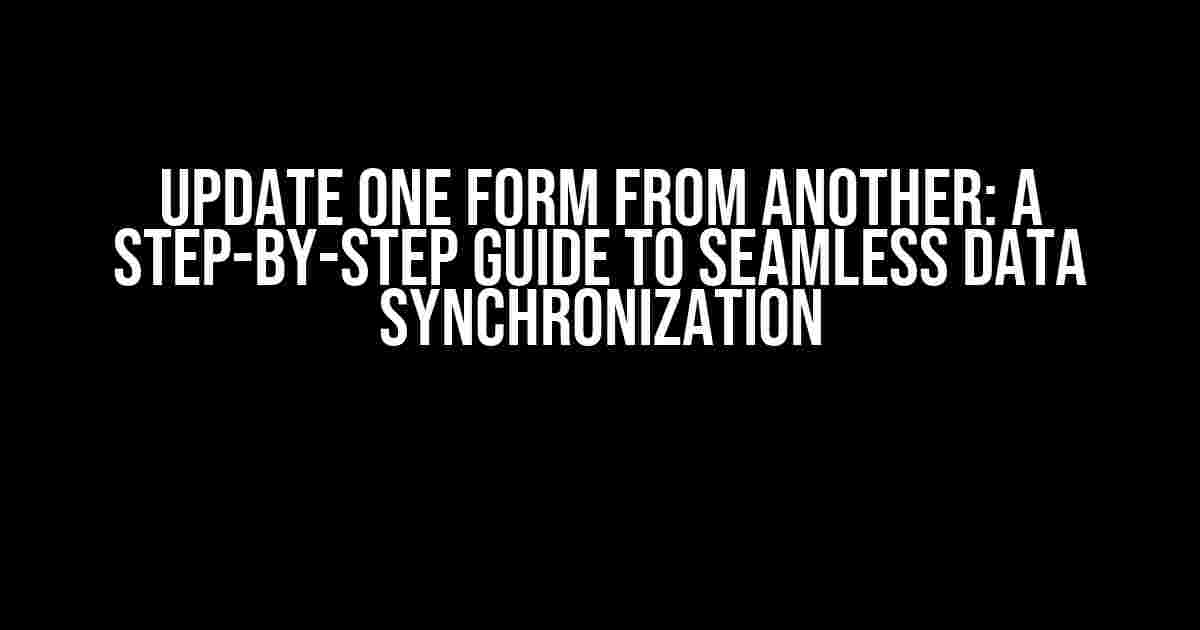Imagine having multiple forms on your website, each collecting crucial information from your users. Sounds like a nightmare to manage, right? But what if I told you there’s a way to update one form from another, seamlessly and effortlessly? Yes, you read that right! In this comprehensive guide, we’ll dive into the world of form synchronization and show you how to update one form from another in no time.
Why Update One Form from Another?
Before we dive into the meat of the matter, let’s discuss why updating one form from another is essential for your website. Here are a few compelling reasons:
- Improved User Experience: By synchronizing forms, you can reduce the amount of data users need to enter, making their journey smoother and more enjoyable.
- Increased Efficiency: Updating one form from another eliminates the need for manual data entry, saving you and your team time and effort.
- Reduced Errors: When forms are synchronized, the chances of human error are significantly reduced, ensuring that your data remains accurate and reliable.
Understanding the Concept of Form Synchronization
Form synchronization is the process of updating one form based on the data entered in another form. This can be achieved using various programming languages, frameworks, and tools. In this article, we’ll focus on using JavaScript and HTML to achieve form synchronization.
Key Concepts to Keep in Mind
Before we dive into the implementation process, it’s essential to understand a few key concepts:
- Form Elements: Form elements are the individual components that make up a form, such as text fields, checkboxes, and dropdowns.
- Form IDs: Each form element has a unique ID, which can be used to reference and manipulate the element using JavaScript.
- JavaScript Events: JavaScript events, such as onChange and onClick, can be used to trigger actions when a user interacts with a form element.
Step-by-Step Guide to Updating One Form from Another
Now that we’ve covered the basics, let’s get started with the implementation process. We’ll use a simple example to demonstrate how to update one form from another.
Example Scenario
Let’s say we have two forms on our website:
Our goal is to update Form 2 based on the data entered in Form 1.
Step 1: Add Event Listeners to Form 1
We’ll start by adding event listeners to the form elements in Form 1. We’ll use the onChange event to trigger an action when the user enters data in the form elements.
<script>
const form1 = document.getElementById('form1');
const nameInput = document.getElementById('name');
const emailInput = document.getElementById('email');
nameInput.addEventListener('change', updateForm2);
emailInput.addEventListener('change', updateForm2);
</script>
Step 2: Create the updateForm2 Function
Next, we’ll create the updateForm2 function, which will be triggered when the user enters data in Form 1.
<script>
function updateForm2() {
const formData = new FormData(form1);
const phoneNumber = formData.get('phone');
const address = formData.get('address');
const form2 = document.getElementById('form2');
const phoneInput = document.getElementById('phone');
const addressInput = document.getElementById('address');
phoneInput.value = phoneNumber;
addressInput.value = address;
}
</script>
Step 3: Update Form 2
Now that we’ve created the updateForm2 function, let’s update Form 2 based on the data entered in Form 1.
<script> updateForm2(); </script>
And that’s it! With these simple steps, we’ve successfully updated one form from another.
Troubleshooting and Optimization
As with any coding project, troubleshooting and optimization are crucial to ensure that your form synchronization works seamlessly. Here are a few tips to keep in mind:
- Use the Console Log: Use the console log to debug your code and identify any errors that may occur.
- Test Thoroughly: Test your code thoroughly to ensure that it works as expected in different browsers and scenarios.
- Optimize for Performance: Optimize your code for performance by minimizing unnecessary computations and using efficient algorithms.
Conclusion
Updating one form from another is a powerful technique that can elevate your website’s user experience and increase efficiency. By following the steps outlined in this guide, you can achieve seamless form synchronization using JavaScript and HTML. Remember to troubleshoot and optimize your code to ensure that it works flawlessly in different scenarios.
Takeaways
- Form synchronization is the process of updating one form based on the data entered in another form.
- JavaScript and HTML can be used to achieve form synchronization.
- Event listeners, such as onChange, can be used to trigger actions when a user interacts with a form element.
- Form IDs and element IDs can be used to reference and manipulate form elements using JavaScript.
With the knowledge and skills outlined in this guide, you’re ready to take your website’s form synchronization to the next level. Happy coding!
| Form Element | HTML Code | JavaScript Code |
|---|---|---|
| Text Field | <input type=”text” id=”name” name=”name”> | const nameInput = document.getElementById(‘name’); |
| Checkbox | <input type=”checkbox” id=”checkbox” name=”checkbox”> | const checkboxInput = document.getElementById(‘checkbox’); |
| Dropdown | <select id=”dropdown” name=”dropdown”> | const dropdownInput = document.getElementById(‘dropdown’); |
Further Reading
Want to learn more about form synchronization and JavaScript? Check out these resources:
Happy learning, and don’t forget to update one form from another!
Here are 5 questions and answers about “Update one form from another” in a creative voice and tone, using HTML:
Frequently Asked Question
Get the scoop on updating one form from another – we’ve got the answers you need!
What is the purpose of updating one form from another?
Updating one form from another allows you to synchronize data and keep your forms in sync, ensuring consistency and accuracy across your records. It’s like magic, but better!
How do I update one form from another?
It’s easy peasy! Simply create a connection between the two forms, specifying the fields you want to update, and voilà! The data will be synced in no time. You can also set up automation rules to make it happen automatically.
What if I have multiple forms that need updating?
No problem! You can create multiple connections between forms, and even set up a cascading update process. This way, when one form is updated, it can trigger updates in multiple other forms. Talk about efficiency!
Can I update multiple fields at once?
Absolutely! You can update as many fields as you need, all at once. This way, you can keep all your forms in sync with just a few clicks. It’s like a dream come true!
What if I need to update forms with conditional logic?
No worries! You can set up conditional logic rules to determine which fields should be updated, and when. This way, you can update forms with precision and accuracy, every time.


